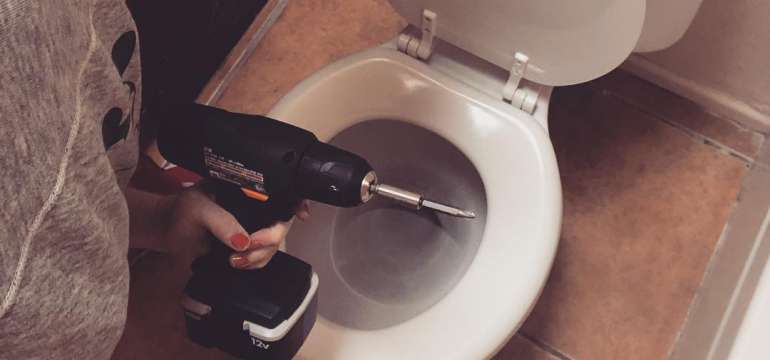A small household malfunction that you have to deal every day with can really cause you stress after a while. When it comes to the rooms you frequently use, like the bathroom, those tiny annoyances can eat up extra minutes of your time or cause you pain.
In this guide, we’ll tackle one common household issue. When your toilet seat won’t stay up and keeps slamming down, it can be startling and painful for users. Coupled with unfortunate timing, a toilet seat that won’t stay up often causes a mess as well—and that, in turn, can cause friction between members of the household. Fortunately, there are several things you can try to repair this problem.
Tighten the screws

First of all, close the toilet lid and look along the back, where the seat connects to the toilet bowl. There should be two white, squarish pieces of plastic. These are the covers for the screws that attach the toilet seat and lid to the actual toilet bowl.
Lift the screw covers and check the screws underneath. Over time, with the regular function of the toilet and the shifting of users’ weight on the seat, these screws can work their way loose. When that happens, the whole seat gets out of whack, and the mechanism may not function the way it should.
Try tightening those screws. If you see any gunk or grime around them, go ahead and clean that off with some strong soap and a damp cloth or paper towel. Dry the screws thoroughly and replace the covers. Then see if the toilet seat works as it should.
If the toilet seat still won’t stay in place, adjust its position

Sometimes a toilet seat has been improperly installed. The seat mounting bolts may not be in the right place, causing the seat to lay improperly against the toilet bowl. Loosen the nuts attaching the toilet seat and slide the seat forward as far as you can. The seat should be as near to the front of the bowl as possible.
Check to see if the toilet seat is level

A toilet seat with a front end that’s tilted forward is sure to fall down, thanks to gravity. Use a level to check whether or not your toilet seat—and your entire toilet—are evenly positioned parallel to the floor. If the whole toilet or the seat itself isn’t level, you can purchase rubber shims to adjust the angle.
Remove the toilet seat cover

If you have a toilet seat cover and you’re having issues with a slamming toilet seat, you may need to remove that cover. Some covers, especially the padded ones, can interfere with the proper function of the toilet seat and lid. Take off all covers on the toilet seat or the toilet lid, and see if that helps.
Try replacing it
In some cases, the toilet seat itself may be old and warped, or it may be defective. If tightening the screws or repositioning the seat in relation to the bolts didn’t work, it might be time to try swapping out the entire toilet seat with a new one. Be sure to follow a walkthrough video or the accompanying instructions, so you attach this new seat in the right position.
Some stores and suppliers offer a slow, close, or soft close type of toilet seat. These can be an excellent alternative to a seat that slams down sharply. The soft close toilet seat gently eases into place, eliminating noise and reducing the likelihood of injury.
Add magnetic pieces or Velcro strips to the toilet seat and lid.
 If replacing the seat isn’t an option for you, you could try attaching a magnet to the edge of the toilet lid. Place another strong magnet just under the lip of the toilet seat at the front. The idea is that the magnet on the upright lid will adhere to the magnet on the seat, hopefully holding the two together.
If replacing the seat isn’t an option for you, you could try attaching a magnet to the edge of the toilet lid. Place another strong magnet just under the lip of the toilet seat at the front. The idea is that the magnet on the upright lid will adhere to the magnet on the seat, hopefully holding the two together.
Depending on your toilet seat’s design and the strength of the magnets you select, that arrangement might be enough to stop the toilet seat falling down when the males in your home are doing their business. Some DIYers also suggest carefully placed strips of Velcro, but that idea has practical and sanitary drawbacks that less advisable than the magnet solution.
If your toilet seat won’t stay up, a self-closing or soft close version is probably the most reliable fix. Investigate products like the Cachet Quiet-Close toilet seat from Kohler, or the Quiet Close Grip-Tight option. These gently closing seats are sure to prevent the loud noises, startles, messes, and potential injuries brought on by toilet seats that won’t stay up.
- If You Have No Hot Water Pressure, Here’s What You Should Do - December 28, 2021
- What is the Right Shower Drain Pipe Size? - January 25, 2020
- Wet Vent Plumbing, What Is It? How Do You Utilize It? - November 17, 2019


Corey Saunders
Friday 1st of May 2020
Hi Kevin, let me begin by saying that my lid/seat is one of the thicker type of ones that is a little nicer, but that is also heavier and doesn't allow it to lean back like the plastic one that came with the toilet. With that being said, and coupled with the fact that I tried everything you had put on here, I finally came up with another solution. I simply drilled a small screw into the bottom of the seat (of course it being one of the thicker kind of seats you can drill into) just deep enough to where the screw wouldn't touch the toilet rim while the seat sits on the "bumpers" under the seat. I then attached a rubber band to the inside of the flush handle (inside the cistern) where a little loop of it hangs out (not too noticeable). From there, when you put up the toilet seat/lid, you simply loop the rubber band around the screw head on the bottom of the seat and it stays put. It cost me a screw and a rubber band, 2 minutes to install, but too much time being aggravated with no solution and failed research on the problem. I just wanted to share with you my solution so maybe it might help someone else eliminate some wasted time and frustration in the future. Thanks!